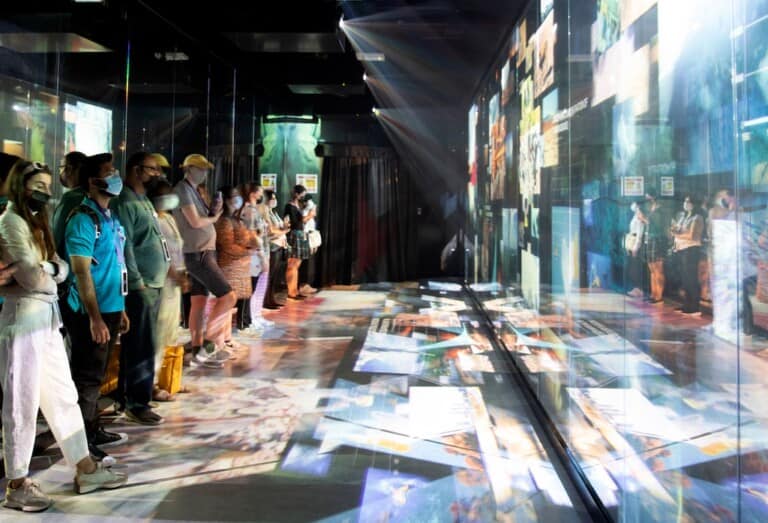First held in London in 1851, World Expos have evolved considerably beyond their original role of showcasing new inventions, from TVs and telephones to ketchup and ice-cream cones. Today, the five-yearly event aims to mirror and predict the aspirations of society. For attraction designers, World Expos present a unique opportunity to see the latest trends unfolding in the realm of experiential entertainment.
Pavilions succeed on the strength of their storytelling and usually rely on video projection to educate and entertain. And there’s the rub: how can one exhibition stand out if all are offering the same kind of visual experience?
To find the answer, let’s look at how visual design and projection at World Expos have evolved, and also how the right technology partner can help adapt and scale the best ideas to fit your next attraction.
World Expo projection technology: the journey from Shanghai to Dubai
Expo 2010 Shanghai was big. It drew a record-breaking 73 million guests and was staged on a site larger than 1,000 football fields. So naturally, the projections were massive. While the scale was ambitious—check the video of this 1,600 m2 amphitheatre projection below—the projectors used had limited brightness and resolution. Also, blending techniques for curved-screen projection were yet to be perfected.
Looking back at a decade of World Expos, it’s truly remarkable to see how far projection mapping has come in the last 10 years.
The game-changer
Expo 2015 Milano was an inflexion point with breakthroughs in projection technology arriving all at once. The first 1-Chip DLP laser projectors were introduced, UST lenses for 1-Chip DLP and 3-Chip DLP projectors foreshadowed a rise in interactive images, and edge-blending software shifted visuals from flat to curved screens.
Designers responded to these new capabilities in surprising ways, from holographic projections to mirrored surfaces that heightened immersion. UAE Pavilion was ahead of its time, mixing analogue effects with holograms to create a 4D attraction. And the Japan Pavilion still looks breathtaking.
The paradigm shifted again at Expo 2017 Astana. Laser projectors had broken the 30,000-lumen barrier, the world’s lightest 12,000-lumen laser projector debuted, and the 10,000-lumen 1-Chip DLP laser was becoming the benchmark projector for 360° panoramas mapped to the screen with new geometric correction technology.
Designers went wild with 4K content as advances in CG blurred perceptions of real and virtual. Germany Pavilion remains a standout with its SeedBoard concept. This was a multisensory interactive device that enticed guests to participate in the show.
Expo 2020 Dubai lights the way forward
Then, last year, Expo 2020 Dubai built on these trends. Projection has become like a second skin, seamlessly conforming to the shape of the space itself. Multisensory elements such as programmed lighting, spatial audio, water features, and mist help guests form sensory memories of their experience.
In theatres, new zero-offset UST zoom lenses eliminated gaps around images, filling the entire projection surface. This allows viewers to reach out and touch the image without casting a shadow.
We also witnessed a shift towards experience personalization using data gathered from preference-tracking apps. Gamified and interactive attractions are taking off. In addition, shareability is now a major priority as designers close the gap between real and virtual worlds, allowing online audiences to participate in performances and exhibitions via IP cameras and live streaming. Colour, resolution, and contrast performance have become paramount to retaining visual impact when images are broadcast.
The award-winning Japan Pavilion at this World Expo demonstrated all these projection innovations. It employed curtain screens, Silky Fine Mist, mirrors and glass, as well as floor projections to create an otherworldly atmosphere. Meanwhile, guests enjoyed a personalized show finale based on the content they showed the most interest in during their tour.
What is next in World Expo projection design? Forward to Expo 2025 Osaka
As a technologically advanced society, Japan is in an ideal position to express the theme of Expo 2025 Osaka: “Future Society for Our Lives”
So, what’s next for visual attraction design?
One of the most requested elements for attractions today is shareability and interactivity. Evolving 5G and IT/IP infrastructure and IoT devices will make Expo 2025 Osaka the most involving and immersive ever. Both for those attending and those watching the show online. As the home of anime, most also expect Japan’s national and corporate pavilions to take the gamification concept to exciting new places.
Watch this space! If you’d like to discuss how to apply the ideas highlighted in this article to your museum, location-based attraction, concert, immersive attraction, artainment show, sporting event, exhibition, trade show, or anything in between, please click here or contact Chad Kunimoto at [email protected].
